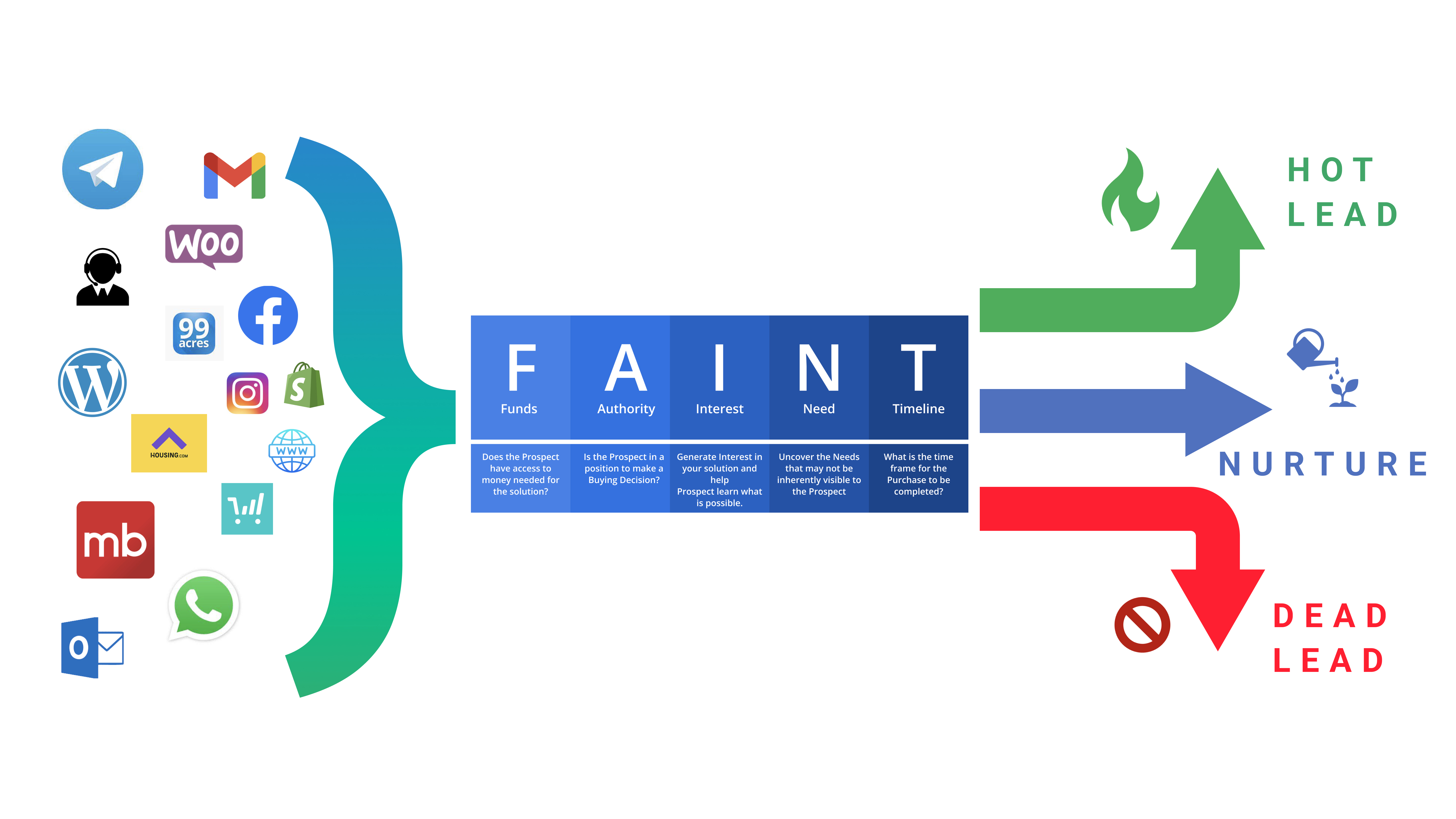FAINT: An Effective Lead Qualification Framework


Lead qualification is a critical process that helps sales teams identify and prioritize high-potential prospects. Businesses can streamline their sales efforts and improve conversion rates by implementing a robust lead qualification methodology. One popular framework used for lead qualification is FAINT, which stands for Fit, Authority, Interest, Need, and Timing. This article will explore FAINT's origins, framework, advantages, disadvantages, and real-world applications as a lead qualification methodology.
Origin and History of FAINT:
The FAINT framework was developed by Aaron Ross and Jason Lemkin, renowned sales experts, as part of their book "From Impossible to Inevitable." FAINT was created to address the challenges sales teams face in scaling their efforts and efficiently qualifying leads. It is suitable for B2B and B2C industries and has gained significant popularity in the technology and SaaS sectors.
FAINT Framework Explained:
The FAINT framework consists of five key elements:
- Fit: Evaluating the fit between the prospect and the ideal customer profile is the first step in lead qualification. Sales teams need to assess whether the candidate aligns with the target market, demographics, and psychographics defined by the organization.
- Authority: Determining the decision-making authority within the prospect's organization is crucial. Sales teams must identify individuals with the power and influence to make purchasing decisions. Engaging with the right stakeholders ensures that Sales Teams focus on those who can drive the buying process forward.
-
Interest: Assessing the prospect's level of interest in the product or service is essential. Sales professionals must gauge the prospect's engagement, enthusiasm, and willingness to explore the offering further. Understanding the prospect's interest helps prioritize leads and allocate resources effectively. - Need: Identifying the prospect's specific needs and pain points is critical to the FAINT framework. Sales teams must delve deep into the prospect's challenges and assess whether their offering can effectively address those needs. Understanding the prospect's needs allows sales professionals to tailor their messaging and positioning accordingly.
- Timing: Assessing the prospect's readiness and timeline for purchasing is an essential aspect of lead qualification. Sales teams must determine if the prospect has an immediate need or the timing fits the sales cycle. Evaluating the timing ensures that sales efforts focus on leads most likely to convert.
Advantages of using FAINT for Sales Qualification:
The FAINT framework offers several advantages as a lead qualification methodology:
- Streamlined Qualification: FAINT provides a structured approach to lead qualification, ensuring that sales teams evaluate critical factors such as fit, authority, interest, need, and timing. This systematic evaluation helps streamline the qualification process and guarantees Sales Teams endeavor focuses on the most promising opportunities.
- Customer-Centric Approach: By focusing on fit, need, and interest, FAINT emphasizes understanding the prospect's specific needs and pain points. This customer-centric approach enables sales teams to tailor their messaging and positioning to resonate with the prospect's unique requirements, increasing the chances of success.
- Effective Resource Allocation: FAINT enables sales teams to allocate resources effectively by prioritizing leads based on fit, authority, interest, need, and timing. Sales professionals can optimize their efforts and improve overall conversion rates by focusing on Leads that align with the ideal customer profile and exhibit strong potential.
Disadvantages of Using FAINT Framework:
While FAINT is a valuable lead qualification framework, it's essential to consider its limitations:
- Subjectivity: FAINT relies on a qualitative assessment of fit, interest, need, and timing, which introduces a degree of subjectivity into the lead qualification process. This subjectivity can vary between individuals and may impact the consistency of lead qualification across the sales team.
- Lack of Quantitative Metrics: FAINT focuses primarily on qualitative evaluation factors and may lack specific quantitative metrics to measure the prospect's fit or level of interest accurately. A lack of quantitative measures can make consistently tracking and comparing lead qualification outcomes challenging.
Summary:
The FAINT framework provides a structured and customer-centric approach to lead qualification, enabling sales teams to evaluate fit, authority, interest, need, and timing. Organizations can streamline their sales process and improve conversion rates by aligning sales efforts with the prospect's requirements. However, organizations should be mindful of the subjectivity and potential need for supplementary quantitative metrics.
Action Points:
- Know More About How You Can Implement a Lead Scoring Mechanism on your Lead Management Board in Pronnel.
- Read more about how you can guide an exploratory Sales discussion to Qualify Leads Based on the FAINT Framework. What questions can you ask? How?
- Learn about other Lead Qualification frameworks like ANUM, CHAMP, FAINT, MEDDIC, and GPCTBA/C&I.
Subscribe To Our Blogs
Get the latest blog notification into your email.